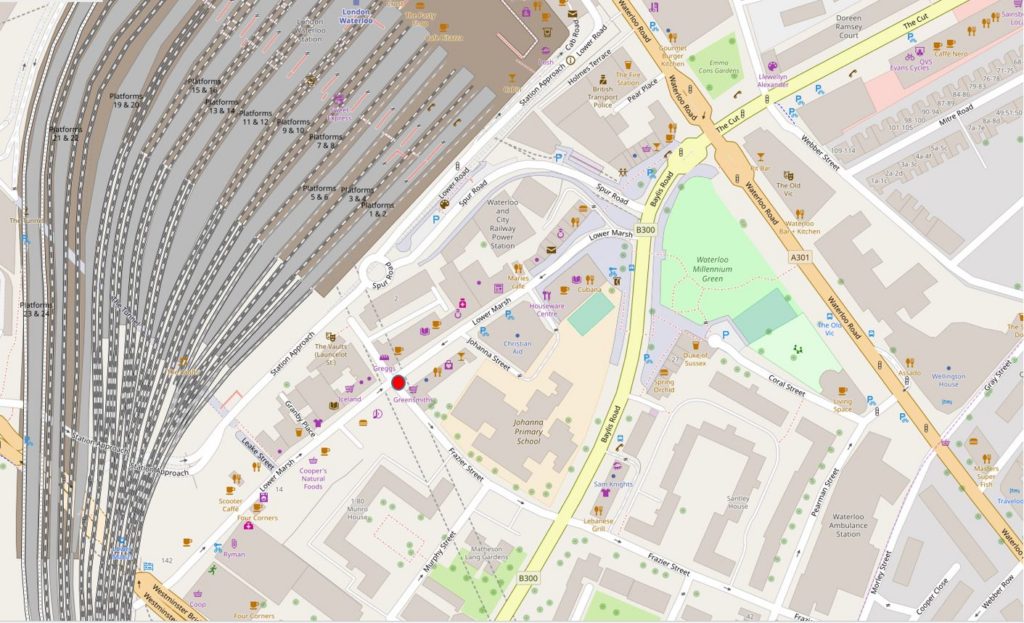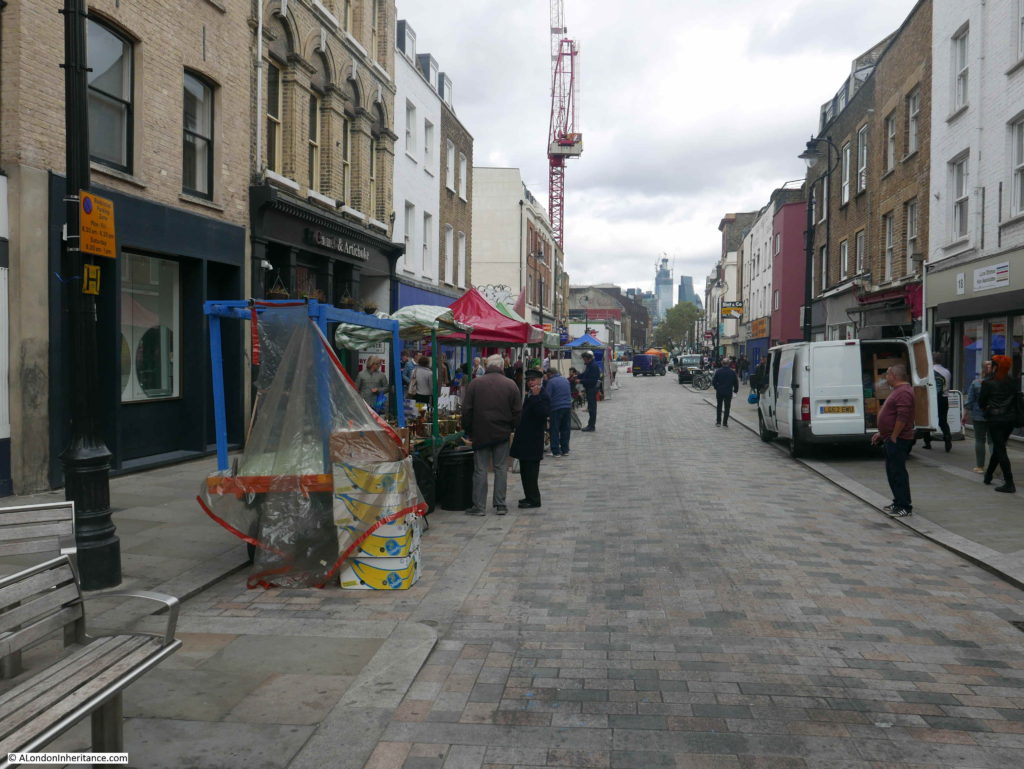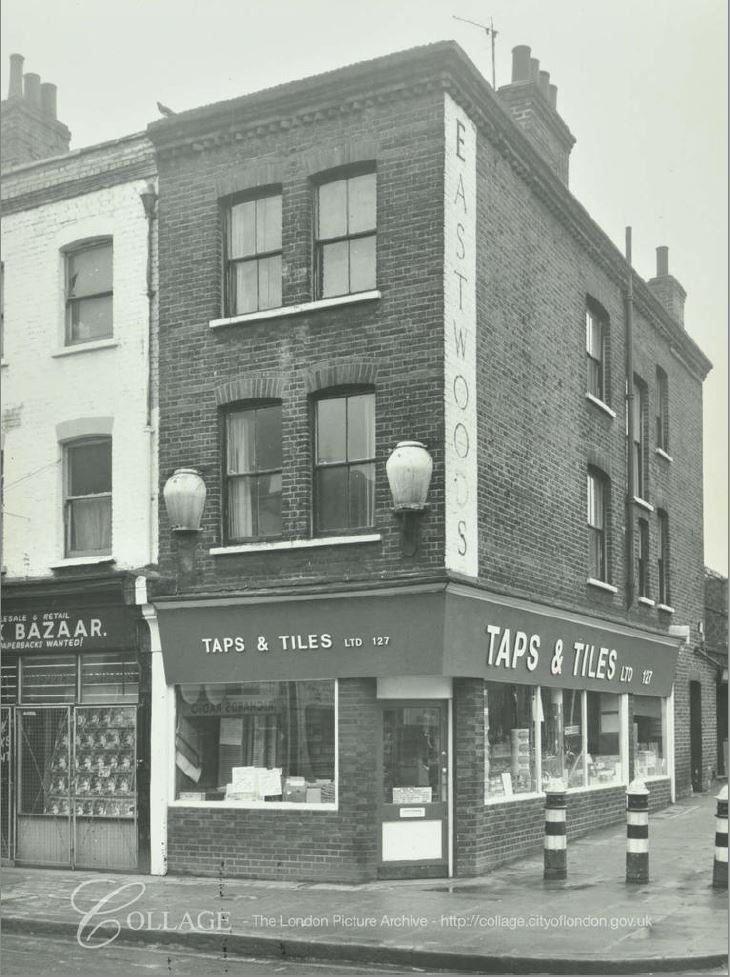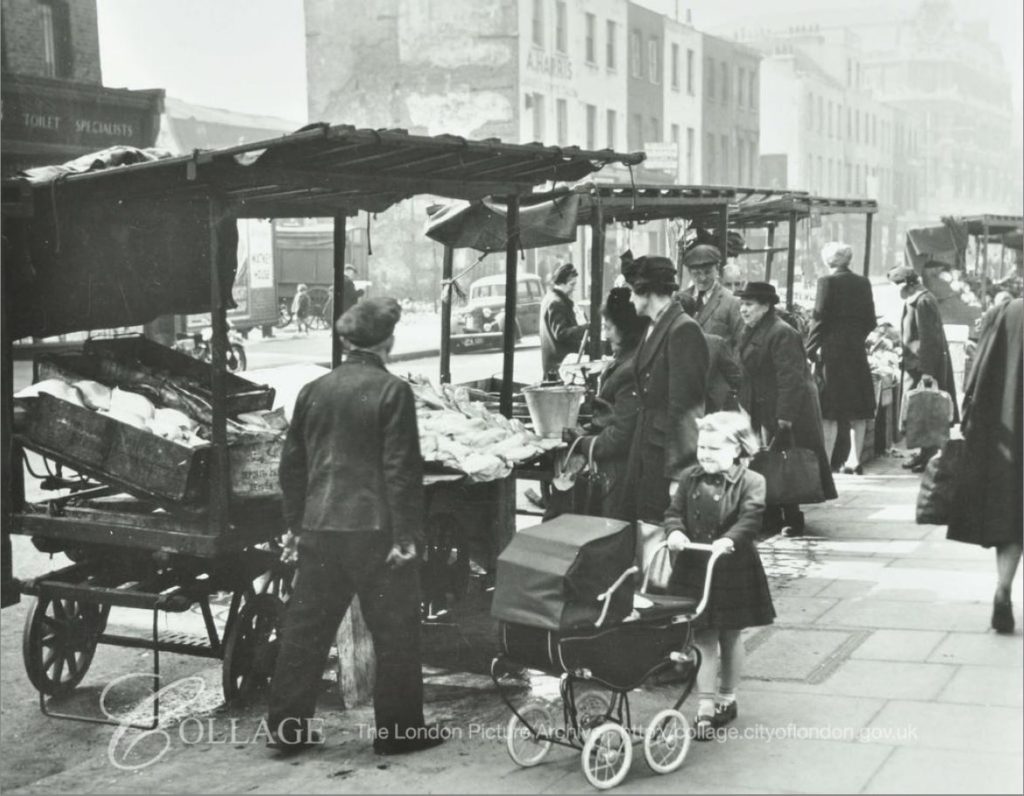For this week’s post, I am in Lower Marsh, just to the south of Waterloo Station, however before getting into the post, can I say a big thanks for all the comments to last week’s post. Within a few hours on Sunday morning, your comments provided:
- The source of the name Flockton – Webster Flockton, who had a tar works in Spa Road, Bermondsey
- It appears there was nothing sinister with Violet Rose Dicker’s disappearance, she probably ran away with her future husband
- The correct location of the photograph – Bevington Street
It is really good to have another of my father’s photos correctly identified, I will never know why he labelled it as Flockton Street, I will check the photos again to see if there is one of Flockton Street as perhaps the wrong photo was labelled. I will also take a walk to Bevington Street to take a photo in the right location.
There is no such mystery with today’s location. I worked around Waterloo for 10 years between 1979 and 1989, and one of the lunchtime walking routes was along Lower Marsh, a street lined with shops and a busy market occupying the length of the street.
This is the shop of L&N Cohen at 27 Lower Marsh on the corner of Frazier Street photographed in 1986:
This is the same building today:
The two photos provide a summary of the changes in the area, as can also be seen across so much of London. The building is no longer the “House for Value” and is now an independent local supermarket selling artisan bread.
I assume the same Cohen family had been running a clothes shop in Lower Marsh for many years. I found the following photo of the same shop in the LMA Collage archive. The photo is dated 1950.
Image credit: London Metropolitan Archives, City of London: catalogue ref: SC_PHL_02_0942_80_3901
The initials changed between the 1950 and 1986 photos, so I assume ownership of the shop moved to later generations of the Cohen family. It is interesting that the same structures can be seen across the front of the first floor of the building, running across the windows. I could not work out what these were for, whether a very large awning, fixing for signage that was once in place, or strengthening of the building wall. What ever it was, it has long gone and the building today has been considerably renovated and extended along Frazier Street.
Lower Marsh runs in the shadow of Waterloo Station. The name hints at what the land in the area was like before the developments between the street and the river. When I worked in the area the street was always known as the Cut rather than Lower Marsh. However the street today named The Cut runs to the east of Waterloo Road.
The following map extract shows the location of the building (the red dot, just to the lower left of centre), Lower Marsh runs from lower left to upper right. Waterloo Station dominates the area to the north. Waterloo Road is the orange road on the right, with The Cut leading off Waterloo Road to the top right corner.
Map © OpenStreetMap contributors.
When I work in the area, the Lower Marsh market was always busy with the street lined with stalls selling all manner of typical market goods, however today, the street appears much quieter with nearly all the stalls selling food. I have not walked along here for a few years, so not sure if this was a typical day, however it is a very different market to that of the 1980s.
The Lower Marsh market has a long history, but trading was not always peaceful. An article in the Illustrated London News on the 27th January 1872 shows some of the problems with attempts at Sunday trading:
“SUNDAY TRADING IN THE NEW-CUT: The Lower Marsh, Lambeth, which is popularly called ‘the New-cut’, has long been the regular weekly haunt of a numerous assembly of costermongers, dealers in fish, rabbits, and pork, sellers of cheap hosiery, pottery, hardware, trinkets and toys, who have been permitted to set up their little stalls, or to place their barrows and baskets at the sides of the wide street. This trade has gone on every Sunday at eight o’clock in the morning to one in the afternoon, while most of the neighbouring shopkeepers were obliged in self-defence, to have their business open at the same time.
Two or three weeks ago, the vestry board of St. Mary’s, Lambeth, passed a resolution to the effect that printed notices should be posted through the parish, cautioning all persons in the habit of exposing goods for sale that such a practice would not in future be allowed on Sunday mornings, and that any person so found offending would be summoned before the magistrate on the charge of creating an obstruction, the penalty on conviction being 40s. It was also resolved that the inspectors of nuisances for the parish should be employed to see that the terms of the notice were strictly enforced. The police authorities had declined to interfere, unless the order were to be applied to shopkeepers as well as to costermongers; but a double force of constables was placed on duty to prevent any breach of the peace.
On Sunday week, the trade began at the usual hour, but at nine o’clock, six of the Lambeth nuisance inspectors, in uniform, appeared upon the scene, and, accompanied by police-constables and followed by a large body of roughs, yelling and hooting, visited the stall-keepers in succession, ordering each to remove the stall, barrow or basket at once. If they merely removed to other places, they were followed by an inspector, who took down the name and address of the offending dealer, informing him he would be summoned.
As a rule, the officers, while performing their disagreeable duty, were treated with civility; but were very generally told that, if prevented selling their goods as usual, the costermongers would be compelled to throw themselves upon the parish, as they mainly depended for their scanty living upon the profits of the Sunday morning sales, when they did more business than on all the other days of the week.”
The articles goes on to state that the issue was discussed further in a number of vestry meetings, with a considerable number of shop-keepers, rate payers, shop assistants and costermongers urging the vestry that regulation rather than prohibition was required.
The vestry agreed on a compromise that allowed the market to go ahead on a Sunday morning, providing the stalls were removed by half-past ten o’clock, before church time.
The article finishes with a sentence that illustrates the working conditions that constrained the lives of so many of the working class:
“It is said that many of the working-class families in Lambeth cannot get their needful purchases for Sunday on Saturday night, because they work late on Saturday and do not receive their wages till the evening.”
Lower Marsh today, looking west with the old Cohen shop immediately on the left:
Another view along Lower Marsh:
There are still many interesting 19th century buildings along Lower Marsh. On the front of one building at 127 Lower Marsh, there are two large urns on the either side of the first floor windows.
Apparently these are Tuscan oil jars and were often found on the facades of former oil shops. The ground floor of the building today is occupied by a Thai Restaurant, however in 1972 it was occupied by “Taps & Tiles”:
Image credit: London Metropolitan Archives, City of London: catalogue ref: SC_PHL_01_251_72_1090A
The Eastwood’s sign on the side of the building in 1972 has disappeared. I have not been able to find out if this was the name of a possible oil shop, or some other business on the premises.
Lower Marsh from Westminster Bridge Road end:
The London metropolitan Archives, Collage collection has a number of photos of the Lower Marsh market over the years, the following are a sample.
The first is one of the earliest I could find and is dated 1896, only 24 years after the Sunday trading issues detailed earlier in the post.
Image credit: London Metropolitan Archives, City of London: catalogue ref: SC_PHL_01_251_77_1062
This is from a time when the majority of shops had awnings and frequently large advertising boards across the facade, as can be seen with the Danish Dairy Company in the above photo. I wonder if the remains of these fixtures could still be seen across the front of Cohen’s shop in 1986.
The following photo is from 1950. The text that goes with this photo states that “the market stretched from Blackfriars to Vauxhall”.
Image credit: London Metropolitan Archives, City of London: catalogue ref: SC_PHL_02_0942_90_3903
I have not been able to find any evidence that the market stretched all the way from Blackfriars to Vauxhall – this would have been a considerable distance. It may have been that, as described in the 1872 Illustrated London News article, costermongers and traders could have sold from baskets and stalls anywhere along the roads south of the river from Blackfriars to Vauxhall, rather than a single, organised market. Street trading was much more haphazard before the 20th century.
This photo is again from 1950, and is at the eastern end of Lambeth Marsh, close to the junction with Waterloo Bridge Road.
Image credit: London Metropolitan Archives, City of London: catalogue ref: SC_PHL_02_0942_90_3903
This final photo from the Collage archive is also towards the Waterloo Bridge Road end of Lambeth Marsh. The photo is from 1950 and shows Waterloo Station in the background.
Image credit: London Metropolitan Archives, City of London: catalogue ref: SC_PHL_01_251_80_3912
I hope the early Friday afternoon that I walked down Lambeth Marsh was not a normal market day, it was very quiet and with considerably less variety than the market of the 1980s, however demographics change and I suspect the market today reflects local demand as it is, rather than as it was.
These changes between 1986 and 2018 can be clearly seen in the changes to 27 Lower Marsh.














Thanks for such interesting research on a street I like to swing past periodically. The Dispensation for an morning early Sunday market in 19thC gives a sobering insight into the hard lives of the local residents.
Fascinating article. I’ve used the market for years and as you say it was always “the Cut.” Very disappointing nowadays with a typical array of bland tented food outlets which always turn out to be a let down. I remember Cohens of course and also a rather seedy looking B’n B and the inevitable chip shop. I still visit from time to time if I’m in that part of town just to see what’s going on.
I love your intriguing posts and how you have followed in your father’s footsteps,absolutely fabulous.
Ahhh, the chipshop :~)
Much frequented during my schooldays at Archbishop Temple’s. Happy days…….
I find it very hard to look at these photos this Sunday morning.
I know, know, know that Londoners had hard lives and many problems in pre war times and in the fifties – but the pictures give a glimpse into the cheerful, cohesive, confident, rooted society I remember from my childhood in Manchester in the fifties and sixties.
Different times in a different land.
It’s hard to see sometimes and makes me feel….sad? Poignant? Disposed of.
Thanks for this, very interesting, like to walk down here every now and then, 1870’s revelations about the allowing of a Sunday morning market give cause to reflect on the hard lives of many 19thC Londoners.
Re Cohen Outfitters
>>. It is interesting that the same structures can be seen across the front of the first floor of the building, running across the windows. I could not work out what these were for, whether a very large awning, fixing for signage that was once in place, or strengthening of the building wall.
From the length of the shadows in the first picture, the photo was taken around midday. That means that the afternoon sun would be on the front of the building, and it would be sensible to have an awning to shade the valuable stock in the windows – you can’t sell faded clothing full price! The awning appears to be folded/rolled back into the higher, box-like horizontal structure.
The lower bar is supporting the clothes rails on which stock is displayed – like this system for hanging rails in modern wardrobes
https://www.screwfix.com/p/smith-locke-rail-centre-bracket-polished-chrome-25mm/4519v
but with much longer vertical (or in this case sloping) rods: you can see the horizontal bars above the shop window level that hold the rail out from the shopfront. Presumably the awning would also protect the outside display in wet weather.
I remember walking along The Cut with my mother in the late 50s.
Thanks for posting
Was just going to post the same comment re structure in front of windows, then saw yours!
I too think they were supports for hanging rails, with an awning above.
Eastwoods were (are?) hauliers with a brickworks on the Medway at Teynham and a large barge fleet. They were based at Welllington Wharf – which was the one on the east side of the railway bridge at Waterloo. There are lots of web sites with information about them. In the early 19th Century they were run by a Mrs. Eastwood. The Lower Marsh sign may be someone different but near enough to guess! In the 1960s I was working in Stamford Street (for Power Laundry and Cleaning News) and was down Lower Marsh market most lunch hours. Good for fruit and veg.
Thank you very much for this morning’s post. It’s an area that I know well. At the far right edge of your map, at the junction of Webber Street and Gray Street (which is actually off the map), one can see part of the name, “The Stage Door”, which is pub on the corner. The name is a reference to the nearby Old Vic theatre. I lived in that pub as an infant from 1964 to 1968, but in those days it was called “The Halfway House”. I have a grainy photograph of the pub in the mid-1960s, with myself standing in front holding the hand of my father, who was the Watney’s brewery tenant. You can see the photo here: https://pubshistory.com/LondonPubs/SouthwarkStGeorgeMartyr/HalfwayHouse.shtml. Like you, I lament the modern tendency to re-name pubs, because of the loss of their historical associations. I recall your earlier post about The Horn, near St Paul’s Cathedral, being re-named the The Centre Page. This was a regular haunt of mine around the turn of the century when I worked in Carter Lane for an investment bank. I have always wondered about which two places “The Halfway House” was the half-way point! Any ideas? Best wishes!
The main market is on Saturdays with it being food stalls in the week.
Ah yes, I knew Lower Marsh in the 1970s and enjoyed the market atmosphere at lunchtime. I have consulted an 1895 Kelly’s directory and find, as you forecast, that 127 Lower Marsh, with the jars, is described thus: “Crane Fdk. Standish & Son, oilmn”.
Curiously quiet when you visited. Did you find the Scooter Caffe? The nearby Leake Street Graffiti tunnel is a short cut under Waterloo Station back to the South Bank. https://www.flickr.com/search/?user_id=74784995%40N00&view_all=1&text=waterloo
Used to go into Cohen’s for vintage (old stock) clothing when I worked in Lambeth in the 90s
This area around Lower Mash still has a certain vibrancy and it shouldn’t be forgotten just how postwar London was truly wrecked, with massive gaps, normally occupied by NCP, National Car Parks on ex bomb sites all over London. Two or three. interesting pointers to the significance of the immmediate area, just along the road from Lower Marsh on the Westminster Bridge Road, was the site of the Necropolis Station, that adjoined Waterloo Station alongside Platform 1, a typically Victorian solution to how to convey dead bodies directly down to Brookwood Cemetary in Surrey (located to relieve pressure on inner city cemeteries), Simply give them their own station ofcourse, the deceased and their families could be conveyed down to Brookwood, near Woking and I suppose if you were ‘lucky’ enough to hold a return ticket, well you got to see another day in Victorian London a seemingly very dangerous place. Not far away ofcourse is a very interesting Museum dedicated to the memory of the life and career of Florence Nightingale ( http://www.florence-nightingale.co.uk) and ofcourse another nearby south London market in Walworth, claims to be the birthplace silent film star, Sir Charles Chaplin. East Street, that still is the sort of mixed use Market also holds an interesting history in that traders did not have the right to a regular pitch, so at 8am, a policeman blew a whistle and traders would rush to claim the best pitches, with shop owners on the Lane claiming the patches outside their front doors. This ended in 1927 when the licensing system was introduced. Many local men were called up in The Second World War and the market declined. In 1948 it was described as “a drab, dead thing, infinitely remote from the cockney tradition”. Thankfully the market survived and evolved. As the population of the area has diversified so have the goods on offer and, along with the traditional fresh fruit and veg, you can now find a vibrant mix of Caribbean food, ethnic clothing, CD’s and household goods.
Unfortunately the market traders suffered when the road surface was tarted up. The works made the street a less attractive spot at lunchtime and by the time they were complete there were fewer stalls.
I’m Ross Cohen. The shop used to belong to my grandfather Lewis Cohen. He set it up following the first World War after he had left the army. Lewis then handed it down to his eldest son Norman (my uncle). The “A Cohen” on the sign shown in the photograph taken in 1950 is presumably my dad, Alan, who died a couple of years ago. Nice to see others are interested in it as well. If anyone knew either my dad or Norman please feel free to leave a post. It would be interesting to talk to you.
I was a trader in the market fro 1985 to 2002 and do remember norman
Hi Ross, just found this article. My Dad was John Cohen, Norman and Alan’s cousin. Not sure if you remember me but I saw your Dad regularly when they went to Arsenal together and came to our house.
Dad used to take me to the shop when he bought his ‘new’ clothes!
Alexa
Possibly the disappearance of thousands of workers from the nearby Greater London Council & Inner London Education Authority buildings in 1985 when they were abolished changed the market significantly – pre 1985 it was a daily thriving market with all manner of stalls plus the shops. It was the go to place for most GLC workers (including myself) at lunchtime. Thanks for the great post & photos.
I was brought up in Waterloo. Lower Marsh and the Cut did have stalls along their length. Didn’t cover the whole length. I remember fruit and veg opposite Windmill Walk. Also I always assumed that the cover photo of Ian Dury New Boots and Panties was the Cohen’s shop as there is Woolies reflected in the window which was on Lower Marsh. Thanks for sharing again.
If you were a regular visitor in the early eighties do you remember George – a slightly disturbed individual who used to walk up and down the Cut chanting “**** off” continuously!